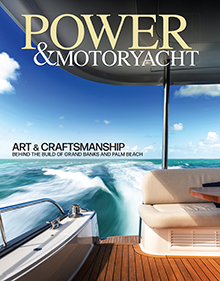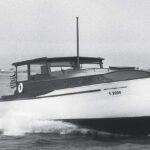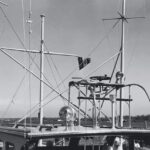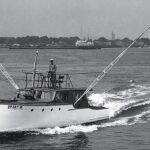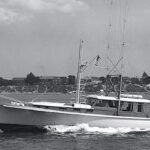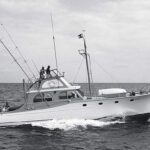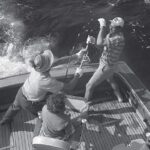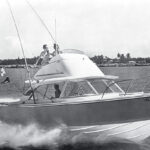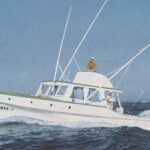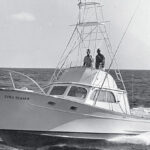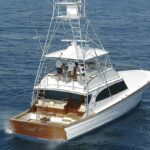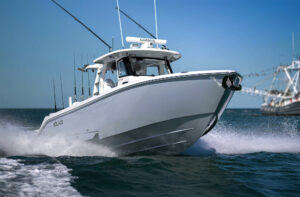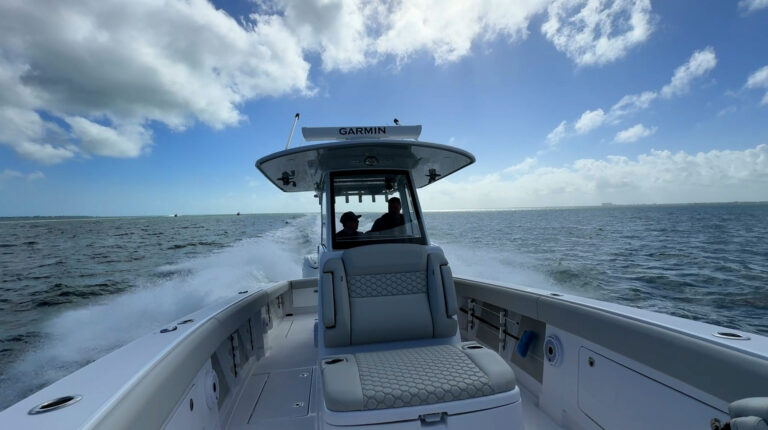Despite all these innovations, many of these boats were plagued with limited range; while some were capable of 30 mph, they were also saddled by inadequate fuel capacity and thirsty gasoline powerplants. According to Martin, this “came up a lot in the 1960’s with people dangerously loading up cockpits with 55-gallon drums of gasoline.”
The modern diesel engine with its high horsepower-to-weight ratio changed all that in the late 1960’s. As Capt. Karl Anderson says, “Builders were able to build a bigger boat and have the horsepower on tap for those long trips.” Anderson is the skipper of Brier Patch, a 58-foot Merritt sportfisherman (see “You Can Get There From Here”). He also grew up at the Jersey Shore a stone’s throw from Ocean Yachts, Egg Harbor, Pacemaker, and Viking, builders that would quickly take advantage of the new engines. “The evolution of diesels equaled more range and pushed for more fuel capacity,” says Martin.
At the same time North Carolina builders were taking convertible sportfisherman design in new directions based upon sea conditions they faced everyday in the Oregon Inlet and the waters off the Outer Banks. Charter captains Warren O’Neill and Omie Tillet are credited with creating the Carolina-style hull in 1960, which features a sharp entry with generous bow flare (to take on vicious head seas) and became the trademark on many boats built in the area. Today’s noted builders like Paul Mann, Ricky Scarborough, Randy Ramsey of Jarrett Bay, Sunny Briggs, and Buddy Davis all grew up in the area, and while some worked directly for O’Neill and Tillet, all were inspired by them to build their own versions of the signature Carolina hull.
The Carolina boats were first built using traditional plank-on-frame construction. Many Carolina builders later adopted cold-molded techniques as well as what is considered the sea change in boatbuilding: fiberglass. The change came quickly. At the 1959 New York Boat Show, 70 percent of the vessels were made of wood; that number would drop to five percent by the 1975 show.
Along with fiberglass construction, which helped companies like Bertram (see “Bertram’s Moppie” below) and Hatteras become ubiquitous, advances in electronics and other ancillaries over the last 25 years have also made a huge difference. “GPS made heroes out of guys. Now they were able to find structure and mark it to fish again,” Anderson asserts. Battlewagons became available with even more power and even larger fuel capacities as well as ice makers and large, insulated fishboxes. Anglers could now run faster and stay out for longer periods of time.
Today the average sportfisherman can cruise at 35 mph and travel 400 miles while doing so, day or night. Huge stowage capabilities and features like functional galleys and home-like accommodations have made them virtually self-sustaining. (According to Sea Recovery 80 percent of its watermakers are installed in sportfishermen.) For many builders, traditional fiberglass layup has evolved into cored infusion, creating a stiffer, stronger, lighter hull. But one thing hasn’t changed from the days of Pilar: You still have to catch the fish once you find them.
Papa and Pilar
Ernest Hemingway settled in Key West in the 1930’s and chartered many vessels to fish the Gulf Stream. But he soon decided he needed a boat of his own, and commissioned Wheeler Shipyards in Brooklyn to build her. The 38-footer was completed in 1934 and named Pilar. She had a rudimentary flying bridge, a cockpit that was dominated by a fighting chair, and a gin pole with block and tackle for hauling the fish aboard, since transom doors had yet to be invented. Hemingway hired Gregario Fuentes, a Cuban gentleman, as his skipper. It is Fuentes who allegedly provided the inspiration for the fisherman in Hemingway’s Pulitzer Prize-winning novel The Old Man and the Sea.

Along with other notables like Zane Grey, Hemingway and Pilar made significant contributions to sportfishing. He wrote about deep-sea angling for the sporting magazines of his day and in doing so inspired a whole new breed of adventurers who would rig their own vessels and set off to catch giant marlin and tuna.

Bertram’s Moppie
After boatbuilding legend Dick Bertram dominated the 1960 Miami-Nassau race aboard a C. Raymond Hunt-designed deep-V boat, Moppie, he used the 31-footer as a plug for the first fiberglass Bertram 31.

The 31 turned out to be the most popular boat Bertram has ever built—by 1970 it had sold more than 1,000. Originally powered by twin 185-hp gasoline engines, she had a purported 48-mph top speed and a cruise of 37 mph. The 1961 model started at $15,900 with standard power; a diesel version rigged to fish cost approximately $24,000.
Today the 31 still has a cult-like following. Restored models are found all over the world, and Web sites like Bertram 31 display hundreds of examples of restored and modified versions and offer links to parts, images, sea stories, and boats for sale.
This article originally appeared in the March 2007 issue of Power & Motoryacht magazine.

